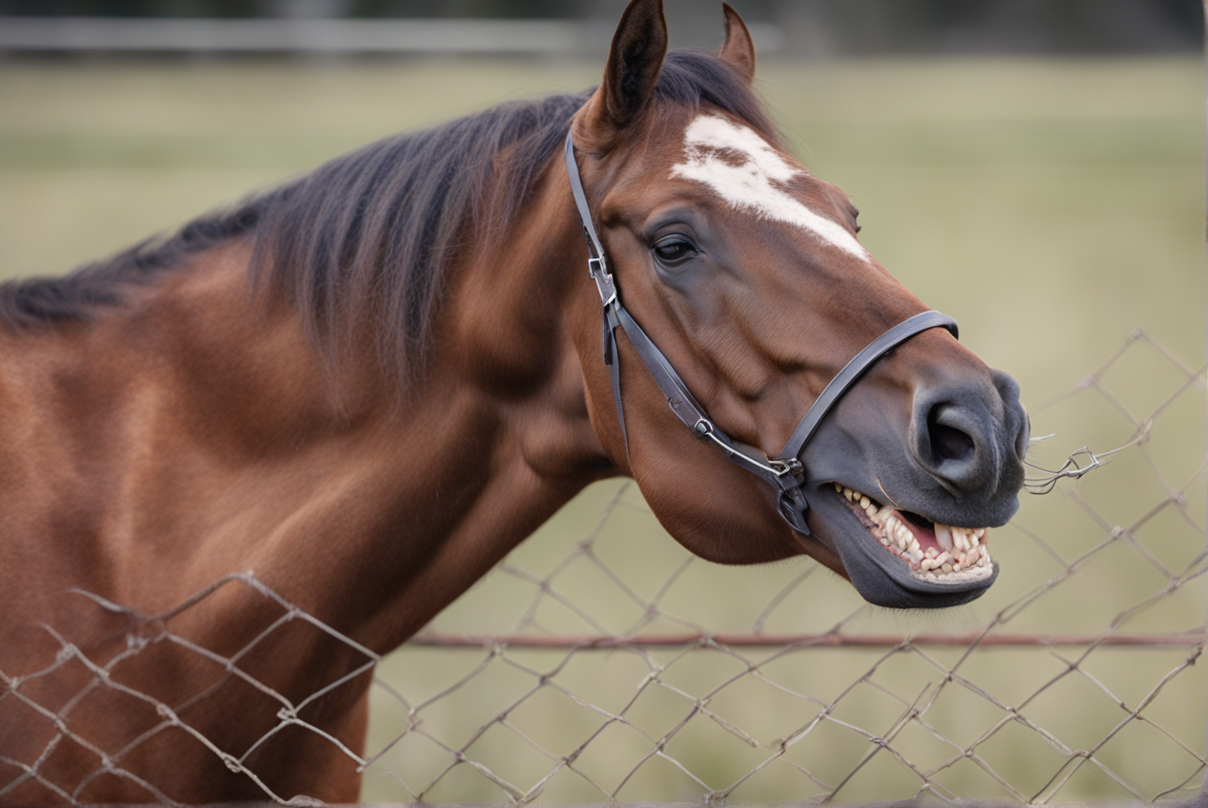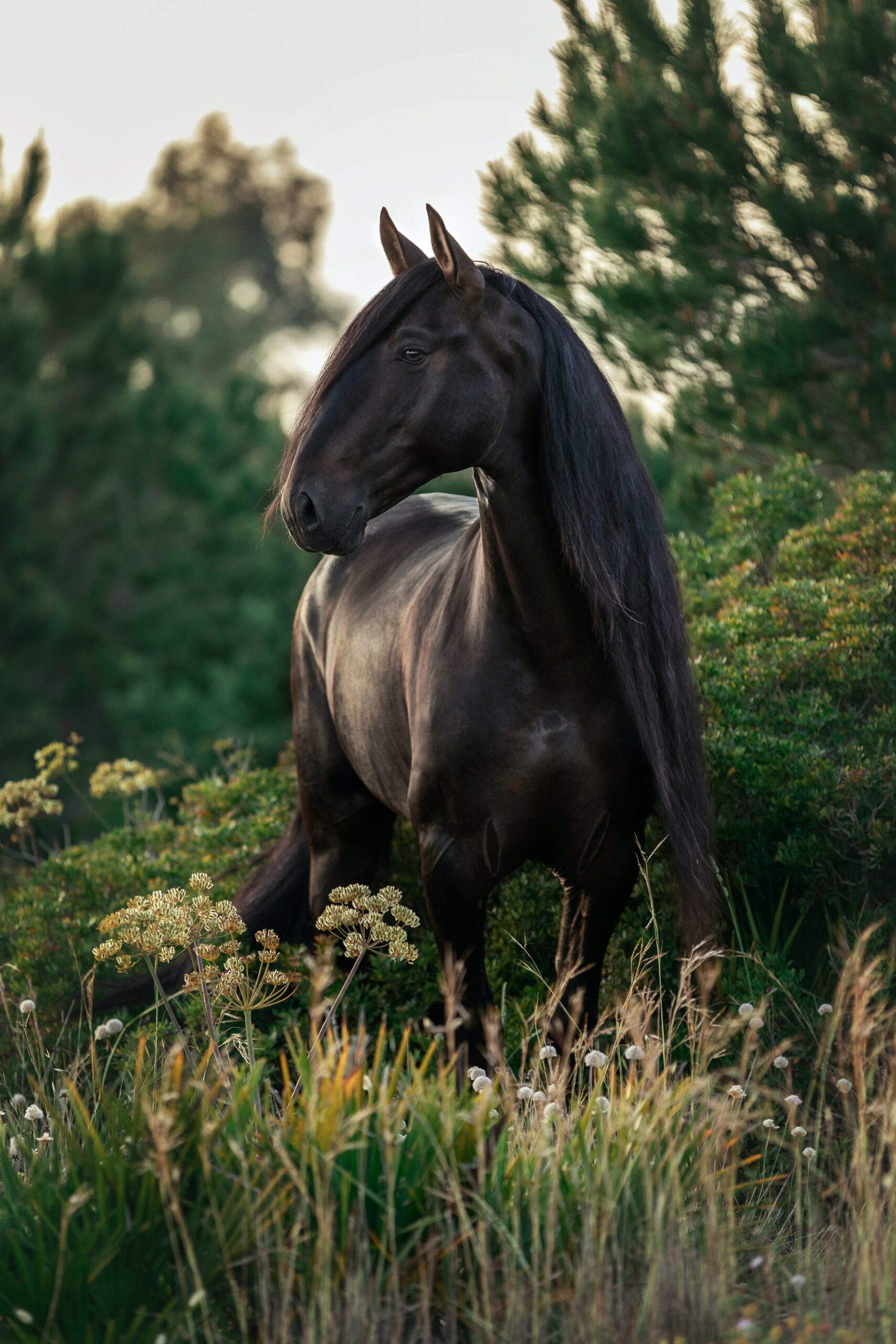I’m out in the pasture, admiring my horse’s unique expressions, and it hits me—why does he look like he just cracked the funniest joke in the barn after munching on hay?Little did I know, this seemingly comical moment is more of a social signal than I thought!
Ever wondered why horses show their teeth after eating?
Let’s unravel this mystery, but first, let me share a funny personal story related to our toothy friends.
So, there I am, feeding my horse a delicious apple.
He munches away happily, but as soon as he finishes, he lifts his upper lip, revealing those magnificent incisors.
I couldn’t help but burst into laughter, thinking he was attempting an equine stand-up routine. Turns out, he was just indulging in a bit of post-snack scent analysis.
Who knew horses had such a refined sense of humor!
As I watched him, it struck me how horses use the Flehmen response to gather information.
It’s like their own version of a post-meal review, giving them insights into the flavors and scents they’ve just experienced.
It’s a bit like us savoring the lingering taste of a fantastic meal!
Now, with that chuckle-worthy tale and a deeper dive into equine scent exploration, let’s uncover the nitty-gritty of why horses put on their toothy grins:
Table of Contents
The Flehmen Response: A Nose for Scents
Okay, let’s talk about that upper lip lift—known as the Flehmen response.
Horses, equipped with an incredible sense of smell, use this peculiar expression to gather information about their surroundings, especially scents related to food or potential mates.

Imagine finishing a delectable meal, and someone hands you a mysterious dish. You’d probably take a whiff, right?
Horses do the same, but their olfactory abilities are far superior. When your horse shows its teeth after eating, it’s like catching them in the act of deciphering the aromatic aftermath of their culinary adventure.
Picture this: your horse indulges in a freshly cut bale of hay. The distinct fragrance of sun-drenched grass wafts through the air.
Lifted lips and bared teeth, it’s as if your horse is saying, “Let me savor the notes of this exquisite hay bouquet.” It’s a sensory journey that goes beyond the act of eating.
Next time your equine friend flashes that post-dinner grin, know they’re not just showing off their dental aesthetics; they’re engaging in a sensory exploration that would put any food critic to shame!
It’s like they’re the sommeliers of the pasture, appreciating the finer details of their meal.
Grins, Giggles, and Equine Bonding
Now, let’s talk about the social side of horse dining etiquette. Horses are remarkably social creatures, and mealtime is more than just refueling—it’s an opportunity for bonding.

When they bare their teeth, it’s not a dental hygiene demonstration but rather a form of communication.
Imagine a scene at a family dinner where everyone is sharing stories and laughter. Horses do something similar during their communal meals, reinforcing social connections and solidifying their bonds with fellow herd members.
That toothy grin is like their way of saying, “Thanks for sharing this meal; I’m feeling the love!”
Consider this: your horse and its pasture pals gather around the hay feeder. As they munch away, there’s a symphony of chewing and occasional whinnies.
The teeth on display aren’t just for show; they’re part of a dialogue—a non-verbal conversation that strengthens the herd’s unity.
So, the next time your horse looks like it’s hosting a dinner party with a hay bale, know that it’s not just about the food—it’s about the camaraderie and shared joy that comes with the equine dinner table.
It’s a visual feast of friendship, where teeth become the punctuation marks in their equine language.
Dental Health Check: A Post-Meal Ritual
Believe it or not, your horse might be conducting a little dental health self-check after a satisfying meal.
As part of the digestion process, horses often grind their teeth, and showing those pearly whites afterward could be a sign of dental comfort.

Think of it as your horse’s version of that post-dental check mirror smile after a thorough cleaning. Showing their teeth is their way of saying, “My molars are feeling fine after that hay buffet!”
Imagine this scenario: your horse finishes a generous portion of hay, and those teeth come into view. It’s like a dental seal of approval, ensuring everything is in working order. It’s a moment of equine contentment, akin to us running our tongues over smooth, clean teeth after a refreshing brush.
It’s a post-meal ritual that assures your horse’s well-being, ensuring they’re ready for the next culinary adventure the pasture has to offer.
So, if your equine companion seems extra cheerful after a meal, it’s probably because their dental health is in tip-top shape!
It’s like a satisfaction survey, but instead of a thumbs-up, your horse gives you a toothy grin to let you know everything went down smoothly.
So, if your equine companion seems extra cheerful after a meal, it’s probably because their dental health is in tip-top shape!
The Joyful Aftertaste
Have you ever eaten something so delicious that you couldn’t help but smile afterward? Well, horses experience that too! When your horse shows its teeth after eating, it could be a simple expression of delight.
It’s like the equine version of savoring a sweet aftertaste, and those teeth are the visible evidence of a culinary bliss.
Imagine your horse just finished a treat or a particularly tasty batch of grain. As it relishes the lingering flavors, a toothy grin emerges, letting you know that mealtime was nothing short of a gastronomic delight!
Playful Horse Games
Believe it or not, horses love to play games, and their post-meal antics can be part of the fun. That toothy display might be an invitation to join in some equine playtime.
Horses are social creatures, and engaging in playful behavior, including flashing teeth, is their way of inviting you into their world of joy and frolic.
Think of it as your horse saying, “I’m fueled up and ready for some play—care to join me?” So, if you notice that cheeky grin, grab a lead rope or a favorite toy, and get ready for some post-meal horseplay!
Relaxed Contentment
Just like us after a satisfying meal, horses experience a sense of contentment. When your horse shows its teeth, it could be a sign of pure relaxation and comfort.
Picture your horse in a sun-drenched pasture, belly full, and muscles relaxed. That toothy expression is the equine equivalent of a sigh of contentment—a visual confirmation that all is well in their world.
So, the next time you see that post-meal grin, appreciate it as a manifestation of your horse’s serene and satisfied state. It’s a moment of bliss captured in a toothy snapshot!
Social Hierarchy Signals
Horses, being herd animals, have a sophisticated system of social hierarchy. The expression of teeth after a meal can be a subtle communication tool within the herd.
It might signify a reaffirmation of their position or a display of submission. Understanding these social cues gives us a glimpse into the intricate dynamics of the horse community.
Imagine observing a group of horses at feeding time. The dominant horse might display its teeth to assert its authority, while others might reciprocate as a sign of respect.
It’s like witnessing an equine diplomatic exchange, where teeth play a role in maintaining order and harmony.
Equine Emotional Expression
Horses are emotional creatures, and their facial expressions are a window into their feelings. A post-meal toothy grin can be a manifestation of various emotions, from happiness to excitement.
It’s their way of sharing their emotional state with us, creating a deeper connection between horse and human.
Consider this scenario: your horse finishes its meal, and as you approach, it greets you with a wide, toothy smile.
It’s a heartwarming moment that goes beyond the physical act of eating—it’s a display of the emotional bond between you and your equine companion.
Horse Behavior
One theory is that horses show their teeth as a way to express contentment or satisfaction.
Just like humans, horses have their own unique personalities and behaviors, and some horses might show their teeth as a way to communicate that they’re happy and satisfied.

Another theory is that horses show their teeth as a way to show dominance.
In the wild, horses live in herds, and they have a social hierarchy.
If a horse shows its teeth to another horse, it might be trying to assert its dominance or to show that it’s the alpha of the group.
Horse Training & Riding
In addition to being a natural behavior, horses might also show their teeth as a result of training or riding.
In horseback riding, showing the teeth is sometimes used as a cue for the horse to stop or slow down.
By showing its teeth, the horse is signaling to the rider that it’s ready to stop or that it needs a break.
Horses might also show their teeth as a result of discomfort or pain. If a horse is experiencing pain or discomfort while eating, it might show its teeth as a way to express this.
In these cases, it’s important to consult a veterinarian to determine the cause of the discomfort and to address any underlying health issues.
Horse Anatomy
Horses have strong, muscular jaws and teeth, and they use their teeth to grind and chew their food. They have a total of 44 teeth, including incisors, molars, and premolars.
Horses also have a unique way of chewing their food.
They have what’s known as a “cheek tooth,” which is a molar or premolar that has a sharp edge.
The cheek tooth is used to grind and crush their food, and it moves back and forth as the horse chews.
FAQs
Is it normal for horses to show their teeth after eating?
Showing their teeth after eating is a natural behavior for horses, and it can serve a variety of purposes, such as expressing contentment or dominance.
In addition, showing the teeth is sometimes used as a cue in horseback riding, and it’s used to signal to the rider that the horse is ready to stop or that it needs a break.
In general, it’s normal for horses to show their teeth after eating, and it’s not usually a cause for concern.
Can showing their teeth be a sign of aggression in horses?
Showing their teeth can be a sign of aggression in horses, especially if it’s accompanied by other aggressive behaviors, such as snorting or pawing the ground.
However, it’s important to note that showing their teeth is not always a sign of aggression.
In some cases, horses might show their teeth as a way to communicate contentment or satisfaction, or as a result of training or riding.
It’s always a good idea to pay attention to your horse’s body language and to the context in which the behavior is occurring to determine the meaning behind it.
Can showing their teeth be harmful to a horse?
Showing their teeth is generally not harmful to a horse, and it’s not usually a cause for concern.
However, if a horse is showing its teeth excessively or if it’s showing its teeth in response to pain or discomfort, it might be a good idea to consult a veterinarian to determine the cause of the behavior and to address any underlying health issues.